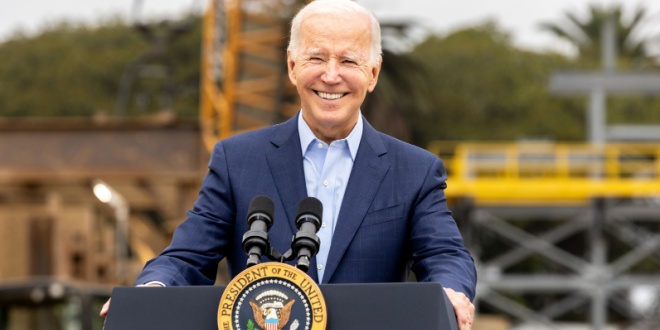One of former President Biden’s last acts as the nation’s chief executive has revived a High Desert city’s opposition to the Chuckwalla National Monument on the east end of Riverside County.
Two weeks before leaving office, Biden signed an executive order that made the 640,000-acre Chuckwalla territory a national monument, much to the chagrin of Blythe officials.
Chuckwalla National Monument stretches from the Coachella Valley to the Colorado River, which is between Blythe and the Arizona border. It is owned by the U.S. government and a group of Native American tribes, including the Cahuilla Band of Indians, the Morongo Band of Mission Indians and the Twenty-Nine Palms Band of Mission Indians.
The monument is managed by the U.S. Bureau of Land Management.
Those tribes, along with eight Riverside County cities and several environmental groups, all supported establishing the Chuckwalla National Monument. The project was also backed by the Coachella Valley Economic Partnership, several Coachella Valley chambers of commerce and a group of state and federal legislators.
“Establishing the Chuckwalla National Monument is another major victory for safeguarding California’s public lands for generations to come,” Sen. Alex Padilla said in a statement issued shortly after Biden signed the executive order. “This historic announcement accelerates our state’s crucial efforts to fight the climate crisis, protect our iconic wildlife, preserve sacred tribal sites, and promote clean energy, while expanding equitable access to nature for millions of Californians.
Gov. Gavin Newson praised Biden’s action – which also established the Sáttítla National Monument in Northern California – calling it an acknowledgment of the Native American tribes that have lived on those lands for hundreds of years.
“Thanks to President Biden and the leadership of California tribes and local communities, we’re protecting 840,000 acres of some of our state’s most culturally significant lands,” Newsom said in a statement, referring to the total acres in both new monuments. “This is a huge boost for our efforts to protect 30 percent of California’s lands and coastal waters.”
Proponents of Chuckwalla National Monument believe it will protect that land’s culture and biodiversity. It will also provide outdoor recreation for many desert communities that don’t have parks, and over time strengthen the region’s economy.
However, Blythe, remains staunchly opposed to the boundaries, which were drawn up by the California Wilderness Coalition, a group that formed to help create the Chuckwalla National Monument.
“The proposed boundaries severely restrict public access to a vast area of land that has long been vital to our community and regional economy,” said Mayor Joseph DeConinck in a statement. “We believe a more measured approach to the monument’s boundaries can preserve the environment while allowing continued access for activities like hunting, mining and outdoor recreation, which are crucial for Blythe’s residents and visitors.”
During a telephone interview, DeConinck restated Blythe’s claim that the national monument is too large, and that Blythe and other High Desert communities stand to be hurt economically by Biden’s executive order.
“Basically, when they started this, the borders were going to go to Joshua Tree,” DeConinck said. “Then they decided to take it all the way to Chuckwalla, which took it to 640,000 acres. We don’t think it needs to be that big.”
The establishment of Chuckwalla National Monument puts that land in the same category as the Statue of Liberty, George Washington’s birthplace, Little Bighorn battlefield in Montana, and the San Gabriel Mountains, among other U.S. historical landmarks.
U.S. national monuments are meant to protect land or a historic site that is deemed to be of national significance.
Any president can create a National Monument using the Antiquities Act of 1906. Congress can also pass legislation to create one.
Restrictions on national monuments vary, but they usually include bans on mining, drilling, logging, and grazing. Some exception are made if those activities were underway before the land was declared a national monument.
Selling land within a national monument is often prohibited, and commercial development is either prohibited or severely restricted. Those restrictions are a big part of why Blythe is opposed to the Chuckwalla National Monument.
“We would expect to benefit from any development in the monument territory,” DeConinck said. “If nothing else it would help keep people from going over to Arizona to buy things, where a lot of the prices are cheaper.
“You wouldn’t believe how many people cross the border to buy gasoline.”
Several solar panel farms are within the monument territory, and several more are expected to be built, but the monument designation will make it more difficult for Blythe to obtain any energy generated there.
DeConinck questions whether anyone in Washington, D.C. understands that.
“The people back there who are making these decisions don’t know anything about the High Desert,” DeConinck said. “I don’t mean any disrespect, but I don’t think Biden knew what he was signing. I think they just put it in front of him and he signed it.”
Blythe has not given up on getting the monument’s borders changed, said Mallory Crecelius, Blythe’s interim city manager.
“We’re going to continue to publicize the issue, and hope the new (presidential) administration reduces the borders, Crecelius said.”We think there’s a good chance of that happening, because the new administration seems to be undoing a lot of what the previous administration did.”
A lawsuit is not being considered, at least for now.
“Lawsuits are not the way we like to do business,” Crecellius said. “We prefer to have good relations with other [legislators] and to work through the legislative process. The city council hasn’t talked about filling a lawsuit.”
 IE Business Daily Business news for the Inland Empire.
IE Business Daily Business news for the Inland Empire.


